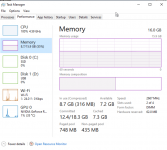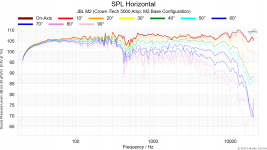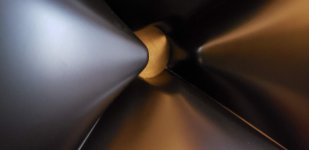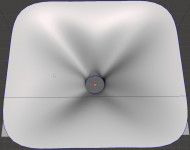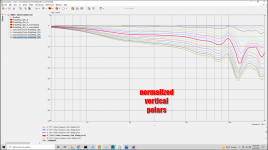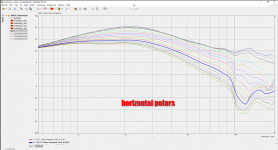Google "ProHSaudio – klaxon de Tweeter HYA0030 PRO, Audio de taille 340L x 270W x 170H 1 ''BMC et accessoires de haut-parleur"
Better yet, just Google "HYA0030"
Better yet, just Google "HYA0030"
Last edited:



Here's a waveguide that's a bit of an "homage" to the JBL Image Control waveguides. This one uses a SB Acoustics SB26ADC tweeter.
The high frequency dip is a bit intentional; basically I wanted to widen the beamwidth at high frequency, and that came at the expensive of an off-axis dip. I doubt a narrow dip at 15khz will be audible.
The beamwidth on this waveguide is exceptionally wide, about 130 degrees of beamwidth in the lower two octaves. Beamwidth narrows in the top octave, which is why I added a diffraction slot.
The reports look strange because for some reason it's drawing two traces for every line. Not sure why. Here's my ATH script:
Throat.Profile = 1
Throat.Diameter = 34 ; [mm]
Throat.Angle = -10
;Throat.Angle = 15 - 5 * sin (p)^2
Coverage.Angle = 75 - 20 * sin(p)^2 - 14*cos(p)^4
;Coverage.Angle = 50
;Slot.Length = 25.4
Slot.Length = 12.7 - 9.7*sin(2*p)^2
Length = 64
OS.k = 1.3
Term.n = 4
Term.q = 0.996
Term.s = 1.5 - 0.5*sin(2*p)^2
Source.Contours = {
zoff -2
point p1 4.68 0 2
point p2 0 14 0.5
point p3 1 15 0.5
point p4 0 16 0.5
point p5 0 17 1
cpoint c1 -18.59 0
cpoint c2 0 15
arc p1 c1 p2 1.0
arc p2 c2 p3 0.75
arc p3 c2 p4 0.25
line p4 p5 0
line p5 WG0 0
}
Mesh.AngularSegments = 80
Mesh.LengthSegments = 32
Mesh.ThroatResolution = 4.0 ; [mm]
Mesh.InterfaceResolution = 10.0 ; [mm]
ABEC.MeshFrequency = 1000 ; [Hz]
ABEC.NumFrequencies = 50
ABEC.SimType = 1
ABEC.Abscissa = 1
ABEC.f1 = 500 ; [Hz]
ABEC.f2 = 16000 ; [Hz]
ABEC.Polars:SPL_H = {
MapAngleRange = 0,90,19
Distance = 2 ; [m]
Offset = 94
}
ABEC.Polars:SPL_H_normalized = {
MapAngleRange = 0,90,19
Distance = 2 ; [m]
Offset = 94
NormAngle = 0
}
ABEC.Polars:SPL_V = {
MapAngleRange = 0,90,19
Distance = 2 ; [m]
Inclination = 90
Offset = 94
NormAngle = 0
}
Output.STL = 1
Output.ABECProject = 1
Report = {
Title = "SB26ADC Image Control Waveguide"
Width = 1600
Height = 900
NormAngle = 0
}
Here's what happens if you take the diffraction slot and you rotate it 45 degrees.
The beamwidth of the waveguide is a little bit narrower, and the high frequency dip is 'pushed' up in frequency by about 10%.
I think the previous way of doing it (like JBL does) is probably superior. But I had to check.
The beamwidth of the waveguide is a little bit narrower, and the high frequency dip is 'pushed' up in frequency by about 10%.
I think the previous way of doing it (like JBL does) is probably superior. But I had to check.
Attachments
If anyone's curious, I simulated the above model using two different systems:
* On an I7 10700F desktop computer, it took 48 minutes to calculate
* on an I7 10750H laptop computer, it took 96 minutes (yes, exactly twice as long)
The I7 10700F has an MSRP of $298-$308, 8 cores and a turbo clock of 4.8ghz
The I7 10750H has an MSRP of $395, 6 cores and a turbo clock that's identical
I increased the throat resolution from 2mm to 3mm for the desktop simulation, so that definitely impacted processing time.
* On an I7 10700F desktop computer, it took 48 minutes to calculate
* on an I7 10750H laptop computer, it took 96 minutes (yes, exactly twice as long)
The I7 10700F has an MSRP of $298-$308, 8 cores and a turbo clock of 4.8ghz
The I7 10750H has an MSRP of $395, 6 cores and a turbo clock that's identical
I increased the throat resolution from 2mm to 3mm for the desktop simulation, so that definitely impacted processing time.
Would you like to expand in ath technical termini how you implemented the JBL approach to a wide top octave?
The polar map looks quite messy, do you see room for optimization?
The polar map looks quite messy, do you see room for optimization?
Did you limit the cores used in ABEC / Akabak? You need to have enough RAM per process to prevent the solving being restricted by moving data in and out of the swap file on your HDD or SSD. I had to upgrade my desktop to >48 GB of RAM to use all 12 threads available, without increasing the solving time versus smaller numbers of threads.
I'll stick some more ram in there, looks like I only have 16GbDid you limit the cores used in ABEC / Akabak? You need to have enough RAM per process to prevent the solving being restricted by moving data in and out of the swap file on your HDD or SSD. I had to upgrade my desktop to >48 GB of RAM to use all 12 threads available, without increasing the solving time versus smaller numbers of threads.
Some of the newer M2 SSDs are so fast, their speed approaches the throughput of DDR3 ram.
For instance, DDR3 ram from about 12 years ago was running at about 2Gb/second : https://www.tomshardware.com/reviews/6gb-ddr3-x58,2372-6.html
A modern $200 Samsung SSD is faster than that! https://www.storagereview.com/review/intel-optane-memory-review
My desktop is using a $56 M2 SSD which appears to be about half that fast.
Attachments
Would you like to expand in ath technical termini how you implemented the JBL approach to a wide top octave?
The polar map looks quite messy, do you see room for optimization?
The polar response above 12khz is a mess, but everything else is really smooth.
The main thing I'm trying to figure out, is if it's possible to "have our cake and eat it too."
Basically:
1) If I want really smooth polar response, from 1khz to 10khz, that's easy. Just use a shallow ATH waveguide, similar to what augerpro is doing in his thread.
2) If I want increased output, a diffraction slot can accomplish that. Even a slot with a depth of 13-25mm will raise your output on the low end by 3dB, minimum.
What I'm trying to figure out, is if some of these "x-shaped" diffraction slots can allow me to increase output on the low end, while keeping the beamwidth wide. It's a game of juggling, basically tweaking the depth of the slot to try to 'push' the dip higher and higher. I could use a diffraction slot that's 6mm in depth and that would certainly move the dip to a frequency where it's inaudible, but at that point the entire point of the diffraction slot becomes questionable.
Complicating all of this is that I'm using a dome tweeter.
If you look at the polar response of the JBL M2, you can see they faced similar challenges. Basically the beamwidth is super wide from 8khz and down, but above 8khz it narrows and by 12khz the beamwidth of the M2 is getting EXTREMELY narrow.
Attached measurement is courtesy of Erin's Audio Corner.
Attachments
Nice work Patrick. When you think you have the final profile would you mind sharing the STL?
Thanks,
X
Thanks,
X
Hello Patrick
Looking at your waveguides I noticed that compared to an M2 waveguide your throats appear to be are much more shallow. They don't have as much depth in comparison. If you measure an M2 the phase plug/bug screen is an 1 3/8 deep from the top of the knuckle. I don't design waveguides so I am not sure how significant that may be. Just wanted to give you a heads up in case it matters. The flare for the knuckles starts at the screen.
Rob 🙂
Looking at your waveguides I noticed that compared to an M2 waveguide your throats appear to be are much more shallow. They don't have as much depth in comparison. If you measure an M2 the phase plug/bug screen is an 1 3/8 deep from the top of the knuckle. I don't design waveguides so I am not sure how significant that may be. Just wanted to give you a heads up in case it matters. The flare for the knuckles starts at the screen.
Rob 🙂
Attachments
Misread - I guess you saw 1990MHz. Actual bandwidth was ~28GBps, so ~4x better than PCIe4 NVMe.For instance, DDR3 ram from about 12 years ago was running at about 2Gb/second : https://www.tomshardware.com/reviews/6gb-ddr3-x58,2372-6.html
Misread - I guess you saw 1990MHz. Actual bandwidth was ~28GBps, so ~4x better than PCIe4 NVMe.
Yowza! Thanks for the correction.
DDR3 ram is practically free these days, so perhaps I should hold onto my 8 year old 16 core Xeon for a little while longer.
The CPUs are eight bucks now and my workstation has been rock solid for as long as I can remember. (Lenovo C30.)
If anyone wants to put together a really cheap workstation for this type of work, here's mine:
dual Xeon E5 2650, Socket 2011 LGA, sells for about $14 per CPU on eBay : https://www.ebay.com/itm/284671355156
I have a mix of Patriot Viper DDR3 memory modules totaling 48Gb : https://www.ebay.com/itm/325070181421
The Patriot memory is "consumer" memory and you could probably do better if you used server memory
For a grand total of about $400 you can put together a sixteen core, 32 thread, 64Gb Xeon workstation
Admittedly this isn't the most efficient setup and it's a bit of a power hog. I've been building computers for 30+ years and this workstation is probably my favorite. There are definitely systems that are faster, but what I like about it is that the think is just ROCK SOLID.
My employer provides hosting services for companies on the Internet, and we have comparable systems like this that were installed around 2012-2014 and some of these systems haven't been rebooted in over three years. That's how solid they are.
For comparison's sake, I've had clients who wanted the fastest systems humanly possible, and they were paying for servers with CPUs that retail for $20,000 per pair and the servers would occasionally reboot spontaneously because they're at the bleeding edge of performance: https://ark.intel.com/content/www/u...inum-8280-processor-38-5m-cache-2-70-ghz.html
Basically like comparing a big block Chevy V6 to a turbocharged Mitsubishi engine.
dual Xeon E5 2650, Socket 2011 LGA, sells for about $14 per CPU on eBay : https://www.ebay.com/itm/284671355156
I have a mix of Patriot Viper DDR3 memory modules totaling 48Gb : https://www.ebay.com/itm/325070181421
The Patriot memory is "consumer" memory and you could probably do better if you used server memory
For a grand total of about $400 you can put together a sixteen core, 32 thread, 64Gb Xeon workstation
Admittedly this isn't the most efficient setup and it's a bit of a power hog. I've been building computers for 30+ years and this workstation is probably my favorite. There are definitely systems that are faster, but what I like about it is that the think is just ROCK SOLID.
My employer provides hosting services for companies on the Internet, and we have comparable systems like this that were installed around 2012-2014 and some of these systems haven't been rebooted in over three years. That's how solid they are.
For comparison's sake, I've had clients who wanted the fastest systems humanly possible, and they were paying for servers with CPUs that retail for $20,000 per pair and the servers would occasionally reboot spontaneously because they're at the bleeding edge of performance: https://ark.intel.com/content/www/u...inum-8280-processor-38-5m-cache-2-70-ghz.html
Basically like comparing a big block Chevy V6 to a turbocharged Mitsubishi engine.
Hello Patrick
Looking at your waveguides I noticed that compared to an M2 waveguide your throats appear to be are much more shallow. They don't have as much depth in comparison. If you measure an M2 the phase plug/bug screen is an 1 3/8 deep from the top of the knuckle. I don't design waveguides so I am not sure how significant that may be. Just wanted to give you a heads up in case it matters. The flare for the knuckles starts at the screen.
Rob 🙂
The super-deep diffraction slot seems to trash the response above 10khz, particularly if you're using a dome tweeter instead of a compression driver. JBL seems to have discovered this as well, and many of their consumer speakers are now using compression drivers, while the ones that use dome tweeters barely have a diffraction slot at all:

Part of the reason that I started this journey of making waveguides again, was because I bought a pair of the JBL Studio 520c speakers, and though they measure fantastic the tweeter sounds horrendous.
I think the issue is that the waveguide suffers from tons of HOMs, due to the high compression ratio and crummy termination:
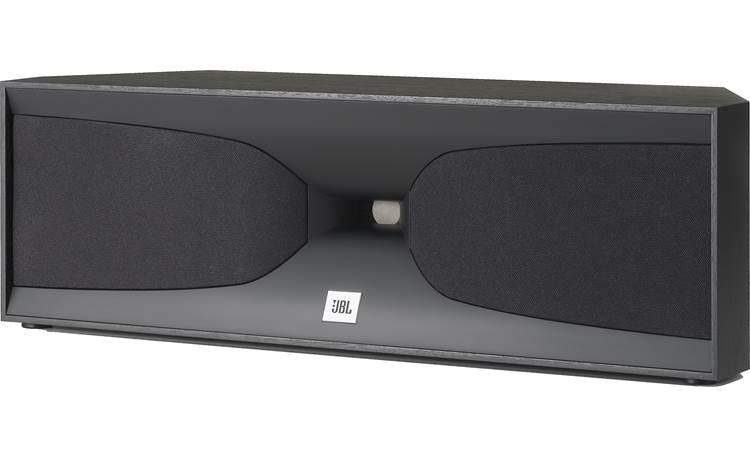
I can't recall ever measuring a speaker that did so well and sounded so BAD
I thought this iteration of the waveguide was going to be "the winner" but it suffers from two issues:
1) At 15khz the horizontal beamwidth is only about 40 degrees. I was really hoping to get that higher. I know I'm limited by the diameter of the dome tweeter but I thought I might be able to improve that. The blue line in the second graph represents the SPL at 60 degrees off axis.
2) Oddly enough, the vertical beamwidth is too wide. I was hoping to use this waveguide in an MTM. At the xover point, the vertical beamwidth of the waveguide is about 120 degrees and that's way too wide. The red line in the 1st graph represents 45 degrees off axis.
I'm beginning to think that a plain ol' vertical diffraction slot might be the way to go here. I could make this into a Unity horn and solve all the issues but I'd really like to make this speaker a two-way not a three way.
These sims took FOUR HOURS on a octa-core Intel I7 :O
1) At 15khz the horizontal beamwidth is only about 40 degrees. I was really hoping to get that higher. I know I'm limited by the diameter of the dome tweeter but I thought I might be able to improve that. The blue line in the second graph represents the SPL at 60 degrees off axis.
2) Oddly enough, the vertical beamwidth is too wide. I was hoping to use this waveguide in an MTM. At the xover point, the vertical beamwidth of the waveguide is about 120 degrees and that's way too wide. The red line in the 1st graph represents 45 degrees off axis.
I'm beginning to think that a plain ol' vertical diffraction slot might be the way to go here. I could make this into a Unity horn and solve all the issues but I'd really like to make this speaker a two-way not a three way.
These sims took FOUR HOURS on a octa-core Intel I7 :O
Attachments
What motherboard would you suggest? A quick lookaround doesn't show many options.If anyone wants to put together a really cheap workstation for this type of work, here's mine:
dual Xeon E5 2650, Socket 2011 LGA, sells for about $14 per CPU on eBay : https://www.ebay.com/itm/284671355156
I have a mix of Patriot Viper DDR3 memory modules totaling 48Gb : https://www.ebay.com/itm/325070181421
The Patriot memory is "consumer" memory and you could probably do better if you used server memory
For a grand total of about $400 you can put together a sixteen core, 32 thread, 64Gb Xeon workstation
Admittedly this isn't the most efficient setup and it's a bit of a power hog. I've been building computers for 30+ years and this workstation is probably my favorite. There are definitely systems that are faster, but what I like about it is that the think is just ROCK SOLID.
My employer provides hosting services for companies on the Internet, and we have comparable systems like this that were installed around 2012-2014 and some of these systems haven't been rebooted in over three years. That's how solid they are.
For comparison's sake, I've had clients who wanted the fastest systems humanly possible, and they were paying for servers with CPUs that retail for $20,000 per pair and the servers would occasionally reboot spontaneously because they're at the bleeding edge of performance: https://ark.intel.com/content/www/u...inum-8280-processor-38-5m-cache-2-70-ghz.html
Basically like comparing a big block Chevy V6 to a turbocharged Mitsubishi engine.
You'll excuse the rube in the room, but this is gain?
If Troels' distortion testing is to be believed, that's roughly -40dB distortion at ~108dB at one meter - at one khz! That used to be good for a midrange!
Is that possible?
- Home
- Loudspeakers
- Multi-Way
- JBL M2 for The Poors

![2022-02-25 13_07_19-VacsViewer - (new) - [Converted from PolarMap_SPL_H].png](/community/data/attachments/937/937179-f333cde99119b019f9484eb309a515ff.jpg?hash=8zPN6ZEZsB)
